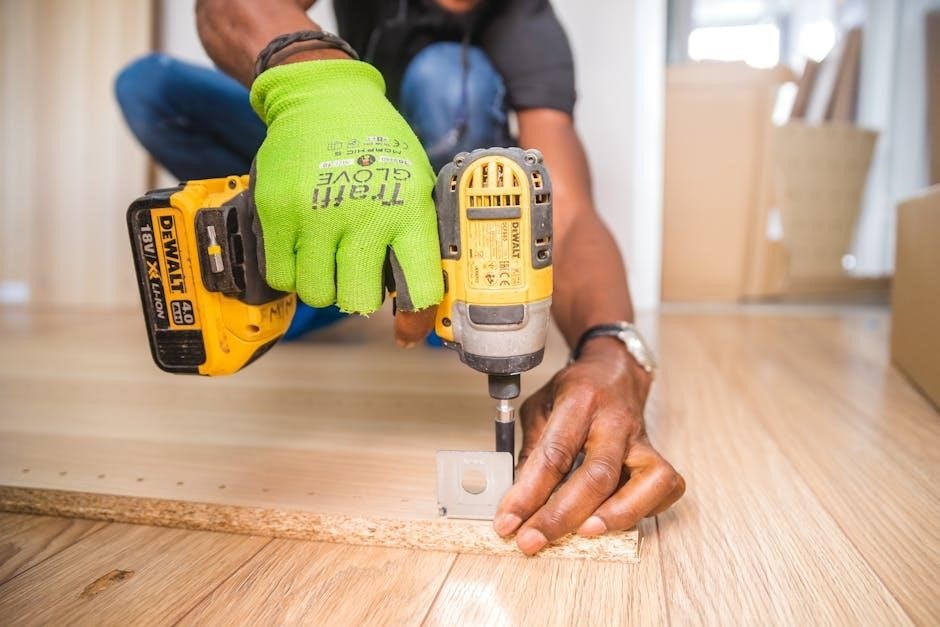The 1992 XJ Clutch Assembly Diagram provides a detailed guide for understanding and servicing the clutch system of the 1992 Jeep XJ Cherokee. This diagram is essential for mechanics and DIY enthusiasts, offering a clear visual representation of components, their relationships, and proper installation procedures. It ensures accurate repairs, maintains vehicle performance, and prevents potential damage from improper clutch assembly. The diagram is a valuable resource for anyone working on the 1992 XJ Cherokee’s transmission system.
Overview of the 1992 Jeep XJ Cherokee
The 1992 Jeep XJ Cherokee is a compact SUV renowned for its durability and off-road capabilities. It was produced during a significant year marked by historical events like the L.A. uprising and the Olympics. The XJ Cherokee featured a robust 4-wheel-drive system and was available with various engine options, including inline-4 and V6 configurations. Its popularity stemmed from its reliability and versatility, making it a favorite among outdoor enthusiasts. The 1992 model saw improvements in suspension and braking systems, enhancing both on-road and off-road performance. Understanding the clutch assembly is crucial for maintaining its transmission system, ensuring smooth gear shifts and optimal vehicle operation.

Importance of a Clutch Assembly Diagram
A clutch assembly diagram is indispensable for understanding and servicing the 1992 XJ Cherokee’s clutch system. It provides a visual representation of components, enabling accurate identification and location of parts. This diagram is crucial for mechanics and DIY enthusiasts alike, as it simplifies complex repair procedures. By detailing each part’s role and interconnections, the diagram ensures proper installation and troubleshooting. It helps diagnose issues like slipping or failure to engage gears, preventing further damage. Regular maintenance and repairs rely heavily on this guide to maintain optimal performance. The diagram’s clarity and precision make it an essential tool for anyone working on the 1992 XJ Cherokee’s transmission system, ensuring longevity and reliability.
Purpose of the Article
This article aims to provide a comprehensive guide to the 1992 XJ Clutch Assembly Diagram, offering detailed insights for mechanics and enthusiasts. Its purpose is to simplify the process of understanding, maintaining, and repairing the clutch system. By breaking down complex components and procedures, the article ensures that readers can confidently perform installations and troubleshoot common issues. It serves as a valuable resource for those seeking to optimize their vehicle’s performance and extend its lifespan. The article emphasizes the importance of proper clutch maintenance, offering practical advice and technical specifications. Whether for DIY projects or professional repairs, this guide is designed to be an indispensable reference, ensuring that all clutch-related tasks are executed with precision and accuracy.

Key Features of the 1992 XJ Clutch Assembly Diagram
The 1992 XJ Clutch Assembly Diagram highlights key components like the clutch pedal, master/slave cylinders, and clutch disc. It provides detailed layout and symbols for easy understanding and precise repairs.
Components of the Clutch Assembly
The 1992 XJ Clutch Assembly consists of the clutch pedal assembly, which translates driver input into mechanical motion. The clutch master cylinder converts this motion into hydraulic pressure, engaging the clutch slave cylinder to activate the clutch. The clutch disc and pressure plate are central to transferring power between the engine and transmission. Additionally, the clutch bearing and fork ensure smooth operation by facilitating the engagement and disengagement process. These components work together to provide precise control over gear transitions, ensuring efficient and reliable performance of the vehicle’s manual transmission system;
Technical Specifications of the 1992 XJ Clutch System
The 1992 XJ clutch system features a cable-actuated clutch mechanism with a 9.25-inch diameter clutch disc. The clutch master cylinder has a bore size of 0.75 inches, while the slave cylinder measures 0.875 inches. The system operates at a pressure range of 1,200-1,500 PSI for optimal engagement. The clutch pedal ratio is set at 6:1, providing a balance between driver effort and precise control. The release bearing is designed for self-adjustment, ensuring consistent performance over time. Hydraulic fluid recommendations include ATF+4 for superior lubrication and heat management. These specifications ensure smooth, reliable operation of the manual transmission system in the 1992 Jeep XJ Cherokee.
Diagram Layout and Symbols
The 1992 XJ clutch assembly diagram is organized into clear, labeled sections, making it easy to identify components and their relationships. Symbols such as gears, arrows, and circles represent parts like the clutch disc, pressure plate, and hydraulic lines; Color coding distinguishes between the master cylinder (red) and slave cylinder (blue). Exploded views detail assembly sequences, while numbered keys explain each part’s function. The diagram uses standardized automotive symbols, ensuring clarity for both professionals and DIY enthusiasts. Torque specifications and alignment markers are highlighted for precise installation. This layout ensures users can follow the assembly process step-by-step, reducing errors and saving time during repairs or replacements.

Understanding the Clutch Assembly Components
The 1992 XJ clutch assembly consists of the clutch pedal, master cylinder, slave cylinder, clutch disc, pressure plate, bearing, fork, and housing. Each component plays a critical role in smooth gear engagement and disengagement, ensuring proper transmission control and vehicle performance. Proper understanding and maintenance of these parts are essential for reliable operation.
Clutch Pedal Assembly
The clutch pedal assembly in the 1992 XJ Cherokee is a critical component that translates driver input into clutch engagement and disengagement. It consists of the pedal, linkage, and pivot points, all working in harmony to activate the clutch master cylinder. Proper alignment and adjustment of the pedal assembly are essential for smooth operation, as misalignment can lead to uneven clutch engagement or complete failure. The clutch pedal assembly is typically mounted to the firewall and connected to the clutch master cylinder via a rod or cable. Regular inspection and lubrication of the pivot points and linkage are recommended to ensure optimal performance. The 1992 XJ clutch assembly diagram provides a detailed visual guide to help identify and repair any issues with the pedal assembly, ensuring precise and reliable clutch operation.

Clutch Master Cylinder
The clutch master cylinder is a vital hydraulic component in the 1992 XJ Cherokee’s clutch system. It converts non-hydraulic pedal input into hydraulic pressure, which is then transmitted to the clutch slave cylinder. The master cylinder consists of a reservoir, piston, and seal, all housed within a cylindrical casing. When the clutch pedal is depressed, the piston moves, creating pressure that engages the slave cylinder to disengage the clutch. Over time, the master cylinder can develop leaks or wear out, leading to clutch failure. The 1992 XJ clutch assembly diagram provides a detailed illustration of the master cylinder’s components and connections, aiding in diagnosis and replacement. Proper bleeding of the hydraulic system after any service is crucial to ensure consistent and reliable clutch operation.
Clutch Slave Cylinder
The clutch slave cylinder is a critical hydraulic component in the 1992 XJ Cherokee’s clutch system, located near the clutch housing. It receives hydraulic pressure from the master cylinder and converts it into mechanical force to engage or disengage the clutch. The slave cylinder consists of a piston, seals, and a housing, all working in tandem to ensure smooth and precise clutch operation. Over time, the slave cylinder can develop leaks or wear out, leading to clutch failure. The 1992 XJ clutch assembly diagram provides a detailed view of the slave cylinder’s connections and operation, making it easier to diagnose and replace. Proper maintenance and bleeding of the hydraulic system are essential to ensure consistent performance and prevent damage to other clutch components.
Clutch Disc and Pressure Plate
The clutch disc and pressure plate are essential components in the 1992 XJ Cherokee’s clutch system. The clutch disc, sandwiched between the pressure plate and the flywheel, is designed to engage and disengage the engine from the transmission. It is typically covered with friction material for optimal grip. The pressure plate, a heavy-duty spring-loaded component, applies consistent pressure to the clutch disc, ensuring proper engagement when the pedal is released. When the clutch pedal is pressed, the pressure plate retracts, allowing the disc to disconnect the engine from the transmission. Over time, the clutch disc can wear down, leading to slipping or chatter. Regular inspection and replacement, as detailed in the 1992 XJ clutch assembly diagram, are crucial for maintaining smooth and efficient shifting. Proper alignment and torque specifications are vital for ensuring correct installation and function.
Clutch Bearing and Fork
The clutch bearing and fork are critical components in the 1992 XJ Cherokee’s clutch system, facilitating smooth engagement and disengagement. The clutch fork connects to the slave cylinder, translating hydraulic pressure into mechanical movement. This movement is transferred to the clutch bearing, which engages or disengages the clutch disc from the flywheel. Over time, the bearing and fork can wear out due to friction and heat, leading to noise or difficulty shifting gears. Regular lubrication and inspection, as outlined in the 1992 XJ clutch assembly diagram, are essential for maintaining their functionality. Proper alignment during installation is crucial to prevent premature wear and ensure optimal performance of the clutch system. Replacement of these components should be done with genuine parts to maintain reliability and extend the lifespan of the transmission.
Clutch Housing and Mounting Components
The clutch housing and mounting components in the 1992 XJ Cherokee are designed to secure the clutch assembly in place, ensuring proper alignment and functionality. The housing is typically made of durable materials to withstand the stresses of the transmission system. Mounting components, such as brackets and bolts, hold the housing firmly to the engine or transmission bellhousing. Over time, these components can loosen or wear out, leading to misalignment and potential damage to the clutch system. The 1992 XJ clutch assembly diagram provides detailed instructions for inspecting and replacing these parts, emphasizing the importance of torque specifications and proper alignment. Regular maintenance of these components is crucial for maintaining smooth gear engagement and preventing costly repairs. Proper installation ensures optimal performance and longevity of the clutch system.

Installation Guide Using the 1992 XJ Clutch Assembly Diagram
The 1992 XJ clutch assembly diagram guides the installation process, ensuring proper alignment and torque specifications for each component, following manufacturer instructions to prevent system damage.

Tools and Materials Required
To successfully install the 1992 XJ clutch assembly, specific tools and materials are necessary. Essential tools include a socket set, wrenches, screwdrivers, and a clutch alignment tool. Materials needed are a new clutch kit, lubricants, and replacement components like the pressure plate and clutch disc. Ensure all parts are compatible with the 1992 XJ Cherokee specifications. Referencing the clutch assembly diagram ensures accurate identification of components. Additional supplies like gloves and safety goggles are recommended for safe installation. These tools and materials can be sourced from automotive stores or online suppliers, ensuring the repair is done efficiently and correctly. Proper preparation is key to avoiding delays and ensuring a smooth process. Always verify compatibility before purchasing to maintain system integrity and performance.
Step-by-Step Installation Process
Begin by disconnecting the battery to ensure safety. Next, remove the transmission to access the clutch assembly. Use a socket set to unbolt the pressure plate and carefully pull out the old clutch disc. Inspect the flywheel for damage and clean it thoroughly. Align the new clutch disc with the alignment tool, ensuring it fits snugly against the flywheel. Reattach the pressure plate and tighten the bolts in a star pattern for even pressure. Reinstall the transmission and reconnect the clutch slave cylinder. Bleed the clutch system to remove air bubbles and test the pedal feel. Finally, reconnect the battery and test drive the vehicle to ensure proper clutch engagement. Follow the diagram for precise alignment and torque specifications to avoid errors. Proper installation ensures smooth gear shifts and optimal performance. Always refer to the clutch assembly diagram for visual guidance during the process.
Troubleshooting Common Issues
Common issues with the 1992 XJ clutch assembly include a spongy clutch pedal, difficulty shifting gears, or complete clutch failure. Start by inspecting the clutch master and slave cylinders for leaks or damage. Air in the hydraulic system can cause a soft pedal, requiring bleeding. If the clutch disc is worn or warped, replace it immediately. Check the clutch bearing for smooth operation and lubricate if necessary. Misalignment of the clutch assembly can lead to uneven wear, so ensure proper alignment during installation. Refer to the clutch assembly diagram to identify components and verify connections. Addressing these issues promptly prevents further damage to the transmission and ensures reliable performance. Always test drive after repairs to confirm proper clutch function.

Maintenance and Repair Tips
Regular inspections of the clutch assembly, including the pedal, master cylinder, and disc, ensure optimal performance. Lubricate moving parts and replace worn components promptly. Consult the diagram for accurate repairs and adjustments to maintain smooth operation and prevent premature wear.
Regular Maintenance Schedule
Regular maintenance is crucial for the longevity of the 1992 XJ Cherokee’s clutch system. Inspect the clutch pedal and master cylinder every 12,000 miles for fluid leaks or damage. The clutch disc and pressure plate should be examined every 24,000 miles for wear. Replace the clutch bearing and fork if any noise or vibration is detected. Lubricate the clutch linkage and pivot points annually to ensure smooth operation. Refer to the 1992 XJ Clutch Assembly Diagram for precise locations and procedures. Following this schedule prevents premature wear and ensures reliable performance, avoiding costly repairs down the line.
Common Clutch Problems and Solutions
Common clutch issues in the 1992 XJ Cherokee include worn clutch discs, master cylinder leaks, and faulty slave cylinders. Spongy clutch pedals often indicate low fluid levels or air in the hydraulic system. Grinding noises during gear shifts may point to a failing clutch bearing or misaligned components. To address these, inspect the clutch assembly using the diagram, bleed the hydraulic system to remove air, and replace worn or damaged parts. Regular lubrication of the clutch bearing and fork can prevent premature wear. Replacing the clutch disc and pressure plate when worn ensures smooth engagement. Consulting the 1992 XJ Clutch Assembly Diagram helps identify and resolve these issues effectively, ensuring optimal performance and extending the lifespan of the clutch system.
Best Practices for Longevity
Regular inspection of the clutch assembly using the 1992 XJ Clutch Assembly Diagram ensures early detection of wear. Avoid riding the clutch, as it accelerates wear on the clutch disc and pressure plate. Clean the hydraulic system periodically to prevent contamination and maintain smooth operation. Lubricate the clutch bearing and fork according to specifications to reduce friction. Avoid sudden, high-RPM clutch engagement to minimize stress on components. Replace worn parts promptly, such as the clutch disc or pressure plate, to prevent further damage. Store the vehicle in a dry environment to reduce rust on clutch housing and mounting components. Adhere to the torque specifications provided in the diagram during reassembly for optimal performance. By following these practices, you can extend the lifespan of the clutch system and ensure reliable operation.

1992 XJ Cherokee Specifications
The 1992 Jeep XJ Cherokee features a 4.0L inline-6 engine, 5-speed manual or 3-speed automatic transmission, and a 4WD system. It boasts a rugged build, high ground clearance, and reliable performance, making it a versatile off-road vehicle with a durable design.
Engine and Transmission Details
The 1992 Jeep XJ Cherokee is equipped with a 4.0L inline-6 engine, known for its durability and off-road capability. It pairs with either a 5-speed manual AX-15 or AX-4 transmission, offering smooth gear shifts and reliable performance. The engine produces 177 horsepower and 220 lb-ft of torque, making it suitable for both on-road driving and rugged terrain. The transmission system is designed to handle the engine’s power efficiently, ensuring optimal performance. These specifications are crucial for understanding the clutch assembly diagram, as they directly impact the clutch system’s functionality and repair requirements. Proper knowledge of these details ensures accurate repairs and maintains the vehicle’s performance.
Brake and Suspension System Overview
The 1992 Jeep XJ Cherokee features a robust brake and suspension system designed for both on-road stability and off-road durability. The front suspension utilizes a live axle with leaf springs, while the rear suspension employs an independent coil spring and shock absorber setup. This configuration provides a smooth ride and excellent articulation for challenging terrain. The braking system includes front disc brakes and rear drum brakes, with a power brake booster for enhanced control. These components work in tandem with the vehicle’s 4×4 capabilities, ensuring reliable performance in various driving conditions. Understanding these systems is crucial for maintaining the vehicle’s overall functionality and safety, complementing the insights provided by the clutch assembly diagram.
Electrical and Wiring Diagrams
The 1992 Jeep XJ Cherokee’s electrical and wiring diagrams are critical for diagnosing and repairing its complex systems. These diagrams provide a detailed layout of the vehicle’s electrical circuits, including the battery, alternator, and wiring harness. They also cover essential systems like the ignition, lighting, and power accessories. The diagrams are particularly useful for understanding the integration of electrical components with mechanical systems, such as the clutch assembly. By referencing these diagrams, technicians can identify faults, trace wiring issues, and ensure proper connectivity. This resource is indispensable for maintaining the vehicle’s electrical health and ensuring all systems operate in harmony, including those related to the clutch and transmission.

Resources for the 1992 XJ Clutch Assembly Diagram
Find the 1992 XJ Clutch Assembly Diagram online as a free PDF download or view it on platforms like Scribd. Official Jeep service manuals and recommends tools.
Online Repositories for the PDF
Several online platforms provide access to the 1992 XJ Clutch Assembly Diagram PDF. Popular repositories include Scribd, ManualsLib, and Jeep enthusiast forums. These websites offer free or paid downloads, depending on the source. Scribd is known for its extensive library of manuals and diagrams, while ManualsLib specializes in automotive documents. Additionally, Jeep-specific forums often share user-uploaded resources, including the clutch assembly diagram. Some repositories may require free registration to access downloads. Always verify the credibility of the source to ensure the diagram’s accuracy. Using specific search terms like “1992 XJ Cherokee clutch assembly diagram PDF” can help narrow down results. This makes it easier to find and download the correct document for your needs.
Official Jeep Service Manuals
Official Jeep service manuals are the most reliable source for the 1992 XJ Clutch Assembly Diagram. These manuals are created by Jeep to provide precise instructions and diagrams for repairs and maintenance. They include detailed schematics of the clutch system, ensuring accuracy and completeness. The manuals are available in both digital and print formats, with part numbers like 881-01-001-9901 specific to the 1992 XJ Cherokee. They cover everything from clutch pedal assembly to master and slave cylinders. Additionally, these manuals often include wiring diagrams and troubleshooting guides. Purchasing an official Jeep service manual guarantees authenticity and clarity, making it an essential resource for professionals and DIY enthusiasts alike. They are widely available through Jeep dealerships, automotive part suppliers, and online retailers.
Recommended Tools and Suppliers
When working with the 1992 XJ Clutch Assembly Diagram, it’s essential to use the right tools and materials. A flywheel resurfacing tool and a clutch alignment tool are critical for proper installation. Trusted suppliers like RockAuto, AutoZone, and JeepPartsWarehouse provide genuine and aftermarket parts. For a reliable clutch kit, consider brands like LuK or ACT. Additionally, a brake bleeding kit and hydraulic line tools are necessary for the master and slave cylinders. Always ensure tools are compatible with your specific 1992 XJ Cherokee model. Using high-quality tools and parts guarantees a smooth repair process and long-term performance. Consult the official Jeep service manual for exact tool specifications to avoid errors during installation or maintenance.
The 1992 XJ Clutch Assembly Diagram is a vital resource for clutch repairs and maintenance. Proper use ensures smooth operation, longevity, and optimal performance of your Jeep XJ Cherokee.
Final Thoughts on the 1992 XJ Clutch Assembly
The 1992 XJ Clutch Assembly Diagram is an indispensable tool for anyone working on the Jeep XJ Cherokee’s clutch system. It provides a comprehensive visual guide, ensuring accurate repairs and maintenance. By following the diagram, users can identify and replace components efficiently, preventing further damage. The detailed layout and symbols help in understanding the system’s intricacies. Regular maintenance, as outlined in the diagram, prolongs the clutch’s lifespan. Whether you’re a professional mechanic or a DIY enthusiast, this resource is crucial for keeping your XJ Cherokee in optimal condition. Its clarity and precision make it a must-have for any repair or upgrade project.
Encouragement for Further Research
Exploring the 1992 XJ Clutch Assembly Diagram encourages a deeper understanding of your Jeep’s mechanics. Delving into repair manuals and online forums can enhance your DIY skills. Watching instructional videos and engaging with automotive communities provides practical insights. Experimenting with small projects builds confidence. Researching OEM specifications ensures reliability. This journey fosters mechanical expertise, empowering you to tackle complex repairs independently. Embrace lifelong learning to master your vehicle’s maintenance and performance.
Importance of Proper Clutch Maintenance
Proper clutch maintenance is crucial for ensuring the longevity and performance of your 1992 Jeep XJ Cherokee. Neglecting the clutch system can lead to premature wear, costly repairs, and even complete system failure. Regular inspections and timely replacements of worn components, such as the clutch disc, pressure plate, and bearings, are essential. A well-maintained clutch ensures smooth gear transitions, optimal engine performance, and safer driving conditions. Referencing the 1992 XJ Clutch Assembly Diagram helps identify potential issues early, allowing for proactive maintenance. By prioritizing clutch care, you can avoid unexpected breakdowns and extend the lifespan of your vehicle’s transmission system, ensuring reliable operation for years to come.




Be the first to reply